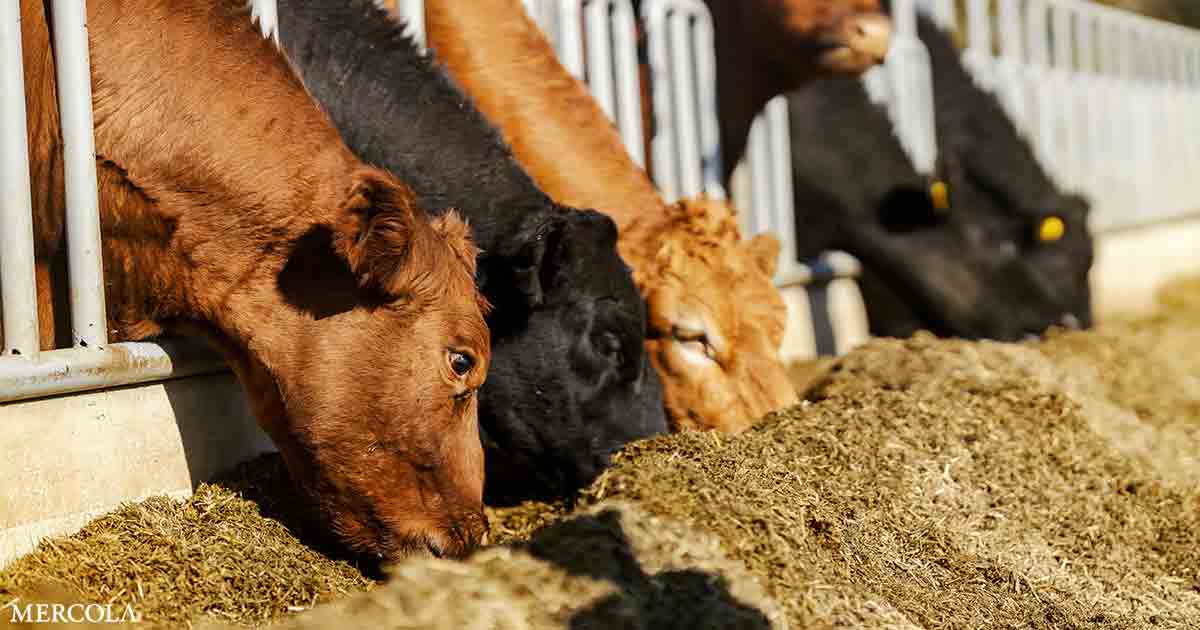Cows, along with other livestock, produce significant amounts of methane gas when raised in concentrated animal feeding operations (CAFOs). These large-scale operations concentrate methane emissions, exacerbating their impact on the environment. Scientists are exploring various solutions to this problem, including a new drug called Bovaer.
This drug, when added to cow feed, has been shown to reduce the amount of methane cows produce,1 although a meta-analysis found a range of results.2 Focusing on a drug like Bovaer is a shortsighted approach to a complex problem, however. Critics point out that Bovaer merely masks the symptoms of a larger issue: unsustainable industrial farming practices.3
Further, a key question looms over this seemingly promising solution: Is Bovaer safe? While the drug’s ability to reduce methane is being heavily promoted, its long-term safety for cows, the environment and the humans who consume milk and meat from treated cows is unknown.
A Closer Look Inside a Cow’s Stomach
To understand how cows produce methane, let’s take a simplified look inside their stomachs. Cows have a unique digestive system with four stomach chambers. The first and largest chamber is called the rumen. Think of the rumen as a giant fermentation vat. It’s a dark, warm and moist environment, perfect for microbes.
The rumen is packed with billions of tiny organisms, collectively called microbes. These microbes are essential for cows because they help break down the tough plant material that cows eat, like grass and hay. Cows, unlike humans, can’t digest these materials on their own. It would be like us trying to eat a tree branch — we simply don’t have the right tools for the job.
Among these helpful microbes are some that scientists consider “bad” in terms of environmental impact. These are called methanogens. As they break down plant material, methanogens produce methane as a waste product. This methane is then released into the atmosphere, mostly through cow burps.
Imagine the rumen as a tiny factory inside the cow’s stomach. The workers in this factory are the microbes. Some workers are responsible for breaking down the tough plant material, while others, the methanogens, produce methane as a byproduct of their work. This methane is like the factory’s exhaust — an unwanted waste product that pollutes the environment, particularly when large numbers of cattle are raised in close proximity.
The Missing Pieces in Bovaer’s Safety Profile
Bovaer, also known as 3-nitrooxypropanol or 3-NOP, is a feed additive to reduce the amount of methane produced by cows. It’s a powder that’s mixed into their regular feed. The idea is that by adding Bovaer to their diet, farmers help cows produce less methane.
Bovaer works by targeting the methanogens in the cow’s rumen. It specifically inhibits, or blocks, the activity of these methane-producing microbes. Before any new drug or feed additive is released onto the market, however, it should undergo rigorous testing to make sure it’s safe. This is true for medicines for humans, as well as for products intended for animals.
Thorough safety testing takes a lot of time and resources. It often takes many years, even a decade or more, to complete all the necessary tests for a new drug. However, this process is necessary for protecting public health. While Bovaer has undergone some safety testing, many experts believe it’s not enough. Most of the studies conducted so far have focused on proving that Bovaer reduces methane emissions from cows.
Initial studies also suggest that Bovaer is safe for cows in the short term, however we don’t have enough information about the long-term effects of Bovaer on cow health. Another major gap in knowledge is Bovaer residues that end up in milk or meat. If these residues are present, what are the implications for human health?
These questions have not been adequately studied. We simply don’t know if there are risks associated with consuming products from cows that have been given Bovaer. “All-in-all, there are warning flags that this drug could have harmful effects,” John Fagan, Ph.D., chief scientist of Health Research Institute, told Children’s Health Defense. “It has been rushed to market without adequate testing for safety to the cows and to the people who drink the milk.”4
Bovaer’s Risks to Human and Animal Health
The limited data available on Bovaer’s long-term effects on cow health raises several concerns. We need more research to understand how Bovaer impacts a cow’s ability to reproduce, their immune system’s ability to fight off diseases and their overall lifespan. Bovaer could have subtle effects on cow health that aren’t immediately obvious but could become significant over time.
One particular area of concern is Bovaer’s ability to disrupt the natural balance of microbes in the cow’s rumen. The rumen is a complex ecosystem, and the microbes within it play important roles in digestion and overall cow health. Changing the microbial balance could have unintended consequences, leading to digestive problems or making them more susceptible to certain diseases, for instance.
Another significant concern is Bovaer or its breakdown products ending up in the milk or meat that humans consume. When a cow is given Bovaer, small amounts of the drug or the substances it breaks down into could be present in the products derived from that cow.
The current safety assessment of Bovaer for human consumption is based on very limited data, meaning it’s unknown whether consuming products from Bovaer-treated cows is safe over the long term. More studies are also needed to investigate whether Bovaer residues could cause allergic reactions in some people, or if they could have other long-term health effects that we’re not aware of yet.
It’s also unknown if consuming products from Bovaer-treated cows is safe for all members of the population, including vulnerable groups like pregnant women, children and people with pre-existing health conditions. Bovaer is already approved in the U.S., Mexico, Canada and the U.K.,5 but given the many unanswered questions about its safety, more research is urgently needed.
André Leu, international director of Regeneration International, told Children’s Health Defense that existing Bovaer safety studies are “totally inadequate,” adding, “They are not long enough to determine common adverse health outcomes such as cancers, oxidative stress, endocrine disruption, reproductive problems, mutagenesis and neurotoxicity. No studies show that treated milk and meat products are safe for children.”6
The Risky Rush Toward a Methane Vaccine
While Bovaer is being marketed as a near-term solution, another risky approach is being developed: a methane vaccine for cattle. Billionaires like Bill Gates and Jeff Bezos are heavily funding research into a vaccine designed to alter the microbial makeup of cows’ stomachs, specifically targeting the methane-producing methanogens.
Bezos, through his Bezos Earth Fund, has invested $9.4 million in this endeavor, while Gates is funding the effort through both his philanthropic organization, the Bill & Melinda Gates Foundation and his investment firm, Breakthrough Energy Ventures.7 The stated goal is to develop a vaccine that significantly reduces the amount of methane cows produce during digestion.
Researchers at institutions like the Pirbright Institute and AgResearch are working to understand how methanogens colonize the digestive tracts of calves and how the bovine immune system responds.8 They’re attempting to identify specific antibodies that effectively target these methanogens, paving the way for a vaccine that could trigger an immune response to suppress methane production.
However, critics like crop scientist and regenerative farmer Howard Vlieger raise serious concerns about the consequences of such a vaccine. Vlieger told Children’s Health Defense that targeting the microorganisms essential for cows’ digestion could severely harm their health, similar to the negative impacts observed when necessary microorganisms in the rumen are eliminated, as research on the herbicide glyphosate has shown.9
The push for a methane vaccine is also supported by organizations like the Global Methane Hub, which is funded by the Gates Foundation, the Bezos Earth Fund and Google, among others.10 The hub claims that reducing methane emissions by 45% by 2030 could have a significant impact on atmospheric conditions, using this as justification for the vaccine’s development.11
They are also advocating for countries to sign the Global Methane Pledge, which aims to reduce methane emissions from livestock and fossil fuels. Some critics find the rapid development and promotion of this technology concerning, especially when considering the vast sums of money involved and the likelihood of unforeseen consequences.
Regenerative cattle farmer Will Harris argues that such technological interventions are unnecessary, as cattle raised on well-managed rangeland are beneficial to the environment, acting as “carbon-converting machines.”12 He contends that the focus on technological fixes creates a cycle of problems that require further technological solutions, benefiting large tech companies while doing little to address the root causes of environmental issues.13
A Regenerative Path Forward
While technological interventions like Bovaer and methane vaccines offer the allure of quick fixes to reduce methane emissions from cattle, they ultimately fail to address the root cause of the problem: unsustainable industrial farming practices.
These approaches involve complex chemical or biological manipulations with unknown long-term consequences for animal health, human health and the environment. Moreover, they perpetuate a system that prioritizes intensive confinement and monoculture farming, which are inherently detrimental to ecological balance.
As highlighted by regenerative agriculture experts, the vast majority of livestock-related methane emissions originate from CAFOs. These concentrated animal populations and the associated manure management practices create conditions that exacerbate methane production. In contrast, regenerative farming practices, which prioritize managed grazing and healthy soil ecosystems, offer a more holistic and sustainable solution.
As Leu explained, “In ranch ecosystems, much of the methane emitted by animals on pasture is degraded by soil and water-based methanotrophic (methane-eating) microorganisms. These organisms do not exist in CAFOs, also known as factory farms, and intensive livestock systems — so 100% of their emissions go into the atmosphere.”14
By mimicking natural grazing patterns, regenerative agriculture promotes biodiversity, enhances soil health and facilitates carbon sequestration.
These practices not only mitigate methane emissions through methanotrophic microorganisms present in healthy soils but also actively sequester carbon dioxide from the atmosphere, improving soil health and overall ecosystem function.
This approach stands in stark contrast to technological fixes that primarily focus on reducing methane at the source without addressing the broader ecological context. Shifting away from CAFOs and embracing regenerative agriculture presents a more promising and enduring path toward addressing environmental concerns related to livestock, while simultaneously promoting animal welfare, human health and the long-term resilience of our agricultural systems.





Leave a Reply